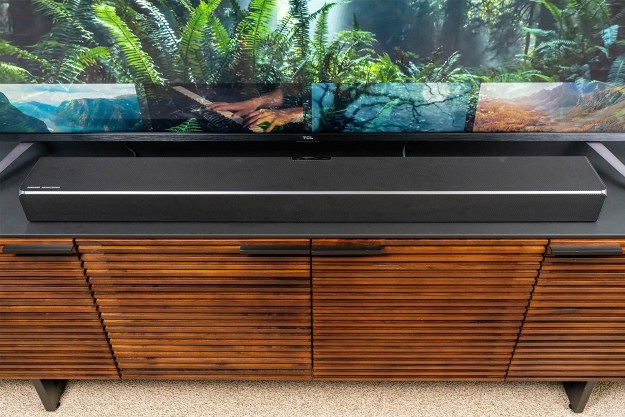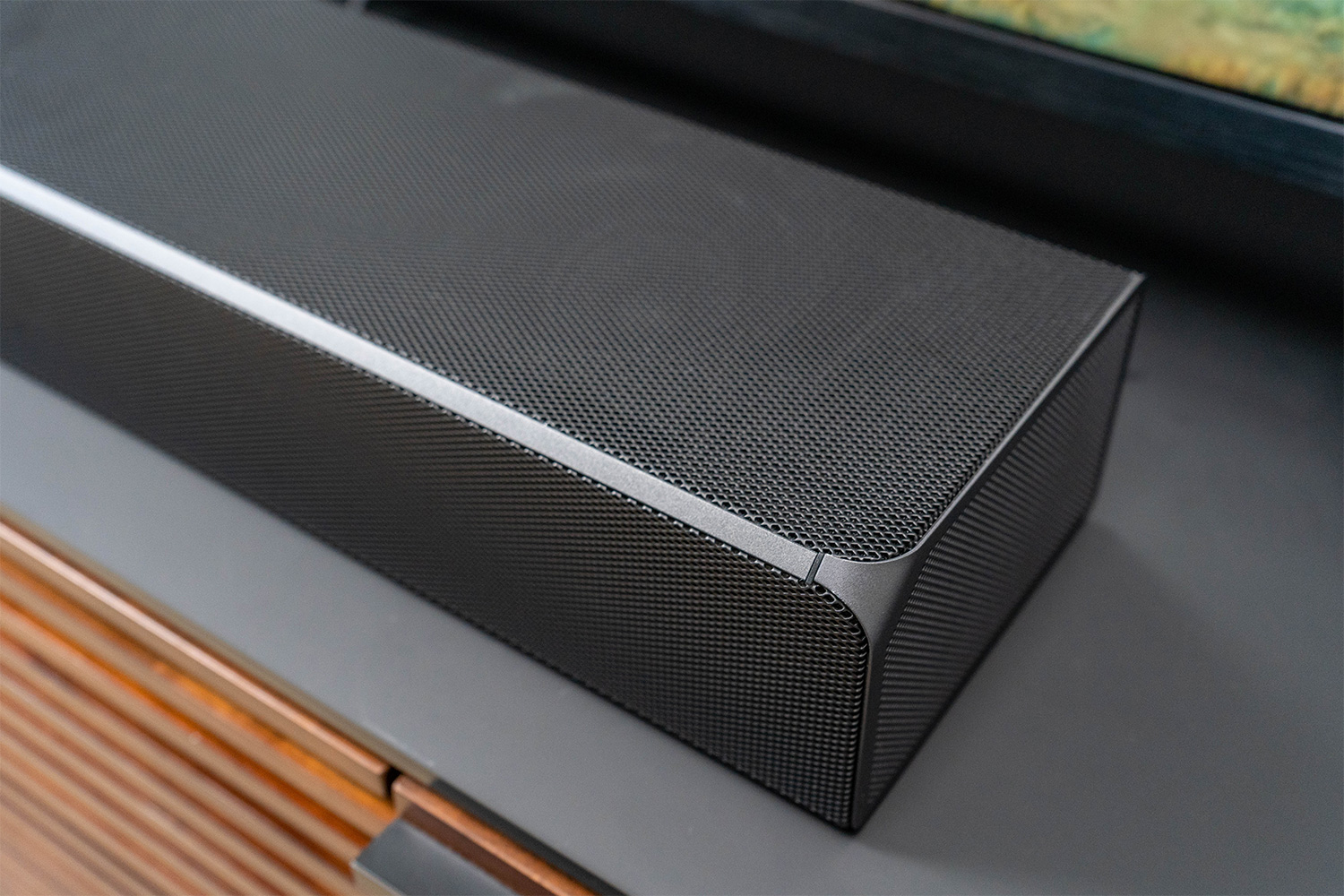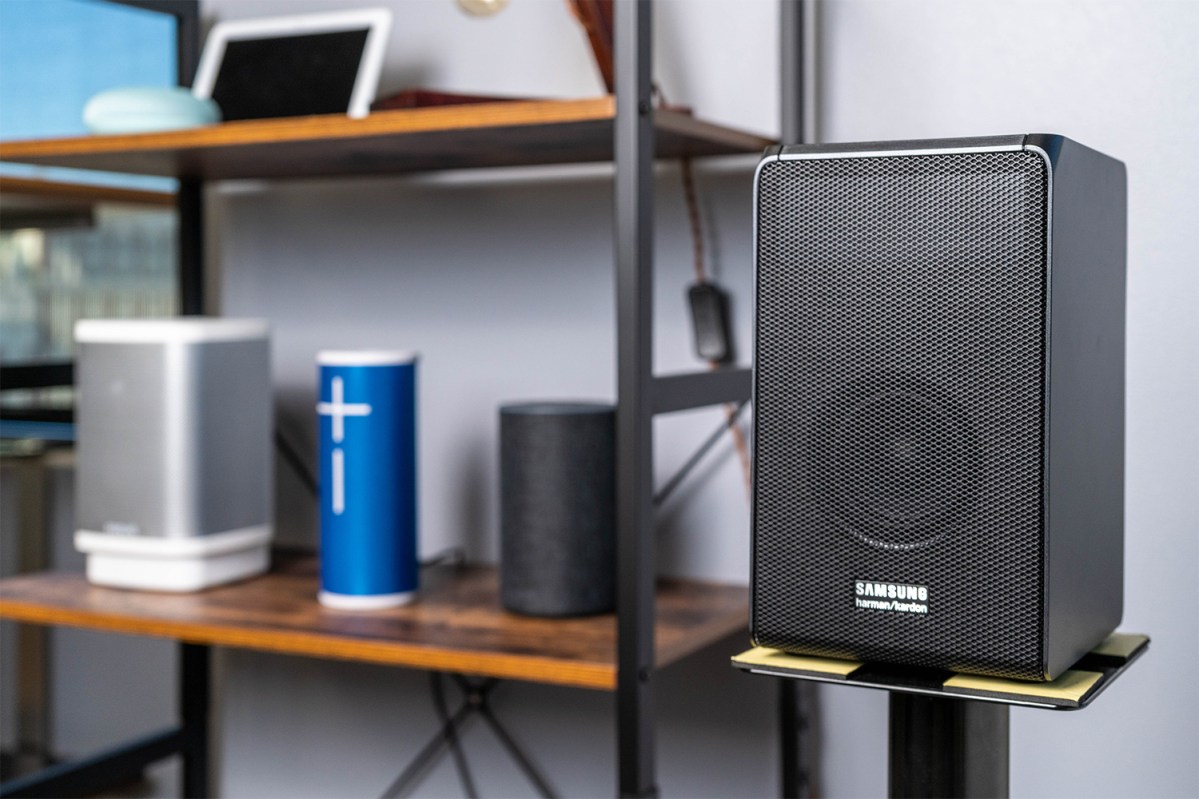
- Smooth and precise Dolby Atmos immersion
- Beefed-up bass response
- Impressive music performance
- eARC support on the way
- Minor latency from TV audio with some models
- Upcoming eARC support is the only real reason to upgrade
If you’re thinking Samsung’s Dolby Atmos powerhouse, the Q90R, looks suspiciously familiar, you’re dead-on. In fact, apart from a few modern updates, the Q90R looks like a carbon copy of its predecessor, the HW-N950, which just so happens to be one of our favorite Dolby Atmos soundbars.
Is it worth upgrading to the Q90R? That will depend on how interested you are in future-proofing features — and whether you have (or will soon have) a new, high-end TV. Still, while we’ve got a few quibbles about the quippier-named Q90R, it’s got plenty of goodies to crow about. Moreover, it will completely replace the N950 soon enough, boasting the latest connection tech and the same great surround sound immersion that made its predecessor a smash hit.
A lot to unpack
Like its N950 twin, the Q90R — so dubbed to match up with the QLED televisions of the same name — is a beast to unload. There are four main pieces covered in Samsung’s familiar, glittery black plastic, including the candy-bar shaped main unit, dual wireless satellite surrounds (which must be plugged in), and a new, side-firing wireless subwoofer. It’s a tough gig dragging the package to your TV room on your own — the bar alone weighs nearly 20 pounds and stretches over 48-inches across, though at just 3.25 inches tall, it fits beneath most TVs.
Boasting a 7.1.4-channel Atmos configuration, the Q90R packs four upfiring drivers (two in the bar and one in each surround speaker), side-firing drivers to bounce sound off your walls for additional immersion, and the usual left, center, and right channels in the bar. The 8-inch woofer completes the package for a total of 17 drivers in all.

As for inputs, you’ll get the same formidable collection as the N950, including dual HDMI inputs with 4K HDR pass-through, including HDR10 and HDR10+. And while Samsung doesn’t like to talk about it since it’s not supported by Samsung TVs, we were also able to pass-through Dolby Vision on an Oppo 203 Blu-ray player.
There’s also HDMI ARC connection and digital Optical connection, as well as wireless connection for Bluetooth and Wi-Fi streaming (via the Samsung Connect app). Samsung claims the ARC connection will also be updated with eARC in August, which would give the Q90R a future-proofing advantage over its predecessor and many others.
While Samsung doesn’t like to talk about it, we were also able to pass-through Dolby Vision on an Oppo 203 Blu-ray player.
Processing includes Dolby Atmos and DTS:X, of course, along with other basic decoding from the surround bigwigs like Dolby Digital Plus and DTS 5.1. While Dolby TrueHD is noted on the HW-N950’s specs, it isn’t for the Q90R. We reached out to Samsung, whose reps confirmed Dolby TrueHD is in fact supported, allowing for Blu-rays to serve up lossless sound. The bar may eventually take full advantage of eARC’s transmission of full-resolution sound from compatible TVs if and when the lossless codec is available to stream. For what it’s worth, we didn’t notice any loss in quality from our favorite Blu-rays, so we’ll take Samsung at its word.
Other notable features include Alexa support (also on the N950) for basic voice control when paired with an Amazon Alexa speaker, as well as Samsung’s UHQ upscaling, which is designed to deliver high-quality music streaming.
What’s new?
With so many familiar features, it’s worth noting the latest additions to the Q90R. While the August arrival of eARC is the big news, also new is Adaptive Sound, which is designed to optimize the incoming audio in real time, including dialogue, so you’ll never miss a word even when the volume is low. We never did in any mode, but Adaptive Sound does add some extra punch, putting dialogue front and center.
Setup
Setup is pretty straightforward once you’ve got everything out of the package and arranged, but you’ll want to make sure you plug in everything in order or the wireless speakers may not sync correctly. As specified in the manual, the order is subwoofer, then each of the surrounds (stands not included), and finally the soundbar itself.

All the connecting cables you’ll need are in the box, including a high-speed HDMI cable for connecting to your TV’s HDMI ARC port. Whether your TV supports eARC or not, HDMI ARC is the only way to get Dolby Atmos sound from it, and it also allows your TV remote to control volume (though you may need to turn on CEC in your TV settings). However, this being a Samsung product, those without a Samsung TV need to take another step: Hold the woofer button on the remote for five seconds until “ALL-TV Remote” is displayed.
Our TCL remote worked with volume automatically, but some may not, and it doesn’t power the bar off. This seems like a rather unnecessary extra step that punishes those who didn’t buy Samsung TVs, but it’s a relatively easy fix. Speaking of Samsung TVs, if you own select models made after 2013, you can also connect the bar over Wi-Fi.
Interface
Apart from that odd TV-remote issue, the Q90R is quite simple to control. Most source switching is done automatically, the right-side LED display clearly spells out exactly what’s going on (from Dolby Atmos to EQ control), and the tactile, cradle-style remote makes it simple to adjust volume and subwoofer levels on the fly.
One thing that isn’t automated is speaker calibration, something we’d hoped Samsung would have added this time around.
One thing that isn’t automated is speaker calibration, something we’d hoped Samsung would have added this time around. That said, it’s not a ton of trouble to tweak the speaker levels yourself for balance, and we really only needed to turn down the surrounds and adjust the side channels.
We need to talk about latency
Since decoding video and audio requires processing time, A/V syncing between TVs and audio devices over a digital output has always incurred some latency, often with TV sound arriving to audio devices slightly behind the video. Lately, however, we’ve noticed this has stretched to become more noticeable on some devices. In fact, Dolby even addresses this directly on its website: “… as devices have added new technologies like speaker virtualization and high-dynamic range video, the processing latency for these technologies has resulted in an overall increase in latency.”
Since both TVs and A/V devices contribute to latency, it’s difficult to isolate the problem, but we noticed some minor delay when connecting the Q90R to multiple TVs, including a TCL 6-series and the new Sony A9 OLED. This may not matter much to most users for multiple reasons. First, the issue was only noticeable when sourcing sound from the TV itself, so connecting streaming boxes and consoles directly resolves it. Second, many upper-tier TVs offer A/V sync and/or eARC, which should alleviate the issue. And third, the latency is minor enough that, depending on your setup, many users may not notice it at all. Still, we did notice it and even checked it against Sennheiser’s Ambeo and Sony’s HT-S350 to make sure, so it’s worth noting.
Performance
Other than the minor latency mentioned above, the Q90R is an absolute dynamo when it comes to delivering powerful sound for TV and movies, just like the N950. In fact, that punchy new sub ups the ante in the lower register, delivering cleaner and more powerful bass to stand as a wonderful bedrock for the 16 other speakers filling the room with sound.
Having discrete surround speakers in a soundbar is a sonic luxury.
Using our go-to Dolby Atmos demo discs, we were reminded that while virtualization has gotten extremely impressive, having discrete surround speakers in a soundbar is a sonic luxury. The system wonderfully conveys moments like the Amaze demo, with better immersion than Sennheiser’s impressive Ambeo bar and room-rocking bass from that wicked subwoofer to bring it all home. While the Ambeo was more accurate with overhead effects like raindrops, the whirling hemisphere of the Q90’s four-piece choir is tough to beat.
Queuing up Black Panther on Netflix was also a brilliant ride, as the true surround conveyed by the speakers brought home action scenes like the famous Busan car chase, with revving engines percolating in vivid realism while Ulysses’ electro weapon swept through the air in buzzing explosions. In fact, we found ourselves reaching for the remote to simmer down that booming sub a bit as it literally shook the walls.
Music, too, sounds pretty great on the Q90R, as its warm midrange and glittery topside blends brilliantly with the sub to render detailed percussion, smooth and sweet vocals, and well-cut guitar strings. Overall, while the system can’t match the definition of dedicated hi-fi setups like our KEF LS50 Wireless bookshelves, there’s plenty of detail on tap, and the expansive soundstage from the lengthy bar extends well beyond the front of the room.
Our Take
While we did note some very minor latency when sourcing sound from some TVs, the Q90R is otherwise another slam dunk from Samsung that offers rich and powerful sound and striking immersion, from Atmos tracks to Spotify jams.
Is there a better alternative?
Samsung’s own HW-N950 soundbar can be a better value because it’s an older model. It’s still great and has many of the same strengths as the Q90R. However, the HW-N950 is going out of stock, so you might not be able to find it at reputable retailers. Luckily, the Q90R is now often on sale at $1,500, a $300 cut from its MSRP.
We’d also be remiss if we didn’t mention Vizio’s excellent $1,000 5.1.4 system, which punches remarkably close to both Samsung bars at a much lower price. In fact, Vizio has a growing family of popular, more affordable Atmos bars for those looking for Atmos at a bargain.
How long will it last?
With eARC on the way and Samsung’s reputation for solid build quality, the Q90R should last well into the future.
Should you buy it?
Yes, the Q90R is a no-brainer for those seeking powerful Dolby Atmos immersion.
Editors' Recommendations
- Samsung launches its flagship Dolby Atmos soundbar with discounted prices
- Samsung’s flagship HW-Q990D Dolby Atmos soundbar gets Roon support
- Nakamichi’s wild Dragon 11.4.6 Dolby Atmos soundbar goes up for preorder this week
- Samsung releases its 2022 soundbars including an 11.1.4-channel flagship with wireless Dolby Atmos
- B&W Panorama 3 soundbar: Easy Dolby Atmos for $1,000



